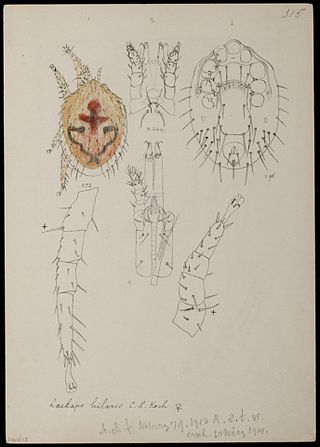
Lundomys molitor, also known as Lund's amphibious rat or the greater marsh rat, is a semiaquatic rat species from southeastern South America.

Poecilochirus is a Holarctic genus of mites in the family Parasitidae. They are relatively large and often found on rotting corpses, where they are transported by beetles. Deuteronymphs are characterized by two orange dorsal shields and in many species a transverse band on the sternal shield. The juvenile development consists of a larval stage, protonymph, and deuteronymph, but no tritonymph. Females are smaller than males. Males guard female deuteronymphs shortly before these mate, and pairs mate venter-to-venter.
Gigantolaelaps is a genus of mites in the family Laelapidae. It is found in the fur of cricetid rodents, most often from the tribe Oryzomyini, from South America north to the southern United States. They are large (>1 mm) and darkly colored and have a complex life cycle.
Androlaelaps fahrenholzi is a species of mite in the genus Androlaelaps of the family Laelapidae. It occurs throughout the contiguous United States, where it has been recorded on the following mammals:
Eutrombicula batatas is a species of chigger.

Haemogamasus is a genus of mites in the family Haemogamasidae. In North America, they mostly infect rodents, in addition to other small mammals such as shrews, talpids, and Virginia opossums.
Laelaps manguinhosi is a species of parasitic mite in the family Laelapidae. In the United States, it has been found on the marsh rice rat in Florida, Texas, and South Carolina. Other recorded hosts include the sigmodontine rodents Scapteromys aquaticus, Akodon azarae, Oligoryzomys flavescens, and Holochilus brasiliensis in Argentina and Oryzomys couesi and Handleyomys melanotis in Mexico. In Venezuela, it mainly infects the oryzomyines Holochilus sciureus and Nectomys, but it has also been recorded on a variety of other mammals and even on a bird. A separate subspecies, Laelaps manguinhosi calvescens, has been described from the ichthyomyine rodent Neusticomys venezuelae.
Listrophorus is a genus of parasitic mites in the family Listrophoridae. North American species with their hosts include:

Listrophoridae is a family of mites in the suborder Psoroptidia of the order Sarcoptiformes. The family contains small, long mites specialized for grasping the hairs of mammals. North American genera include:
Oryzomysia oryzomys is a parasitic mite in the genus Oryzomysia of the family Atopomelidae. It has been found on the marsh rice rat in Georgia. It was formerly known as Chirodiscoides oryzomys in the family Listrophoridae, but was later transferred to the atopomelid genus Oryzomysia.
Prolistrophorus bakeri is a parasitic mite in the genus Prolistrophorus. Together with the Argentine P. hirstianus, it forms the subgenus Beprolistrophorus. P. bakeri has been found on the hispid cotton rat, marsh rice rat, and cotton mouse in Georgia, South Carolina, Texas, and Florida and on Oryzomys couesi in Colima. It was formerly placed in the genus Listrophorus.
Prolistrophorus grassii is a parasitic mite in the genus Prolistrophorus. It was described as Listrophorus grassii in 1954 from the marsh rice rat in Georgia. In 1974, Fain and Hyland placed it in Prolistrophorus and in 1984, Fain and Lukoschus redescribed the species on the basis of collections from the marsh rice rat in Georgia, Alabama, and Florida and the southern bog lemming in Indiana, West Virginia, and Iowa.
Radfordia palustris is a species of mite in the subgenus Hesperomyobia of the genus Radfordia. It has been recorded on the marsh rice rat in Florida, Georgia, and South Carolina.

Laelaps is a genus of common parasitic mites in the family Laelapidae. Species, with their hosts, include:

Bothrops fonsecai, or Fonseca's lancehead, is a species of venomous snake in the family Viperidae. The species is endemic to Brazil.
Ascidae is a family of mites in the order Mesostigmata.
Melicharidae is a family of mites in the order Mesostigmata.
Neotrombicula fujigmo is a species of harvest mite. It is an ectoparasite of shrews and rats. N. fujigmo is found in the Indomalayan realm and has been recorded in Myanmar and India. Cornelius Becker Philip and H. S. Fuller described the species in 1950, initially placing it in the genus Trombicula. The specific epithet comes from the military slang FUJIGMO.
Mercedes Delfinado is an acarologist from the Philippines, who was a recipient of a 1962 Guggenheim Fellowship. She is a specialist in bee mites, and published widely on insects of south-east Asia. For over twenty years she was a Chief Editor for the International Journal of Acarology. Multiple species were named in her honour.





